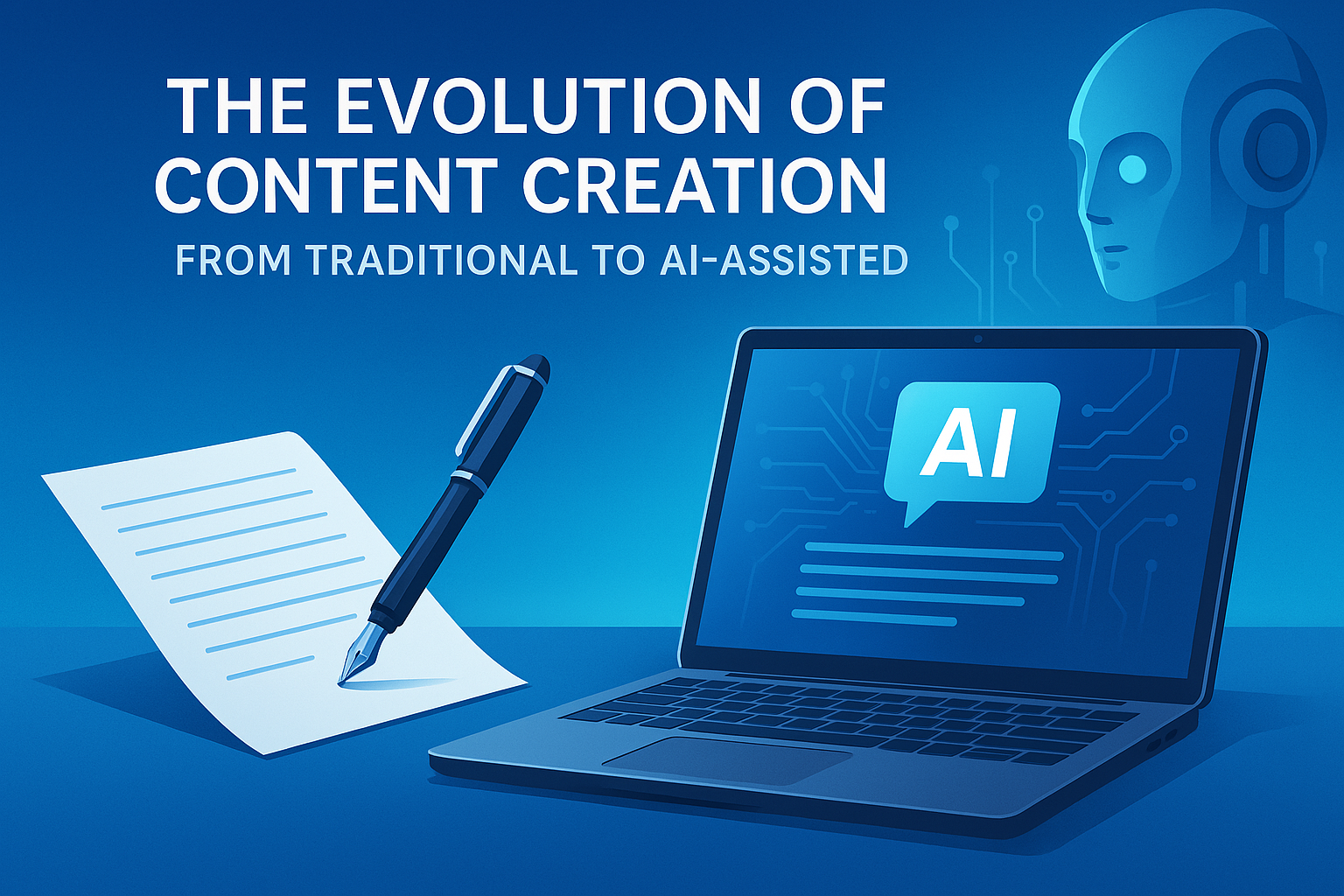The Quiet Before the Algorithm
Once, there was quiet. Not total silence, but a kind of analog hum—pens scratching against paper, old keyboards clacking in a sunlit room that smelled like burnt coffee and ambition. This was content creation, a pre-Internet frenzy. Pre-AI. Just a writer and their thoughts—raw, often chaotic, but real. Very real.
I remember writing a newsletter in 2012. My fingertips were literally cramped because I was typing on one of those aging Dell laptops where the spacebar was… temperamental. The content was passable. The caffeine-fueled panic behind it? Absolutely unforgettable.
And now? Content breathes differently. It’s synthetic but soulful, or maybe it’s soulless and we’re just pretending not to notice. Either way—welcome to the era of AI-assisted content creation. A ride smoother than butter on toast, unless, of course, the machine hiccups mid-sentence and turns your product description into a Shakespearean love letter. (Been there. Fixed that.)
When Content Was Handmade (And Felt Like It)
There was a time—some might argue a better time, though nostalgia’s a tricky liar—when writing content was entirely human. Painstaking, glorious, and riddled with imperfections.
- Manual Processes
Everything—yes, everything—was crafted manually. From brainstorming to final edits, creators sweated out every adjective. Spell check? Sure, but not Grammarly whispering in your ear. It was just you and Word 2007, maybe Hemingway’s ghost hovering nearby, judging your adverbs. - The Mind as Muse
Traditional content depended heavily (arguably too heavily) on our moody, unpredictable friend: human creativity. Brilliant? Sometimes. Blocked? Often. There were days ideas flowed like a river after rain—and others where you’d rather alphabetize your spice rack than write another word. - One-Size Content
Back then, personalization was… not really a thing. You wrote for “the audience,” not your audience. A faceless blob of readers you hoped resonated with what you were saying. No data. No dashboards. Just vibes.
Honestly, it was beautiful in its own way. Like writing a love letter and mailing it into the void, hoping someone read it.
Enter AI: The Typing Partner You Never Knew You Needed (Or Maybe Did)
Let’s fast-forward, kind of like when you scrub through Netflix because the episode’s getting slow. Here we are—2025—and machines write poems now. Or at least, they try.
- Generative AI: The Star of the Show
What started as autocomplete has become everything-everywhere-all-at-once. Tools like GPT-4, Jasper, Copy.ai—they don’t just assist. They perform. They build drafts, pitch angles, suggest synonyms, and sometimes (creepily) anticipate what you’re trying to say before you do. It’s both exhilarating and eerie, like getting a text from your future self. - Automation Is the New Espresso Shot
Need 30 product descriptions before lunch? Done. Want your podcast transcribed and turned into a blog post? Easy. AI doesn’t get tired. It doesn’t call in sick. But—small warning—it also doesn’t understand heartbreak, unless you program it to pretend it does. Which is weird. But also helpful? - Personalization to the Point of Obsession
Want your blog to whisper sweet nothings to someone in Des Moines while shouting marketing jargon at a VP in Tokyo? AI can do that. It’s dissecting behavior like a digital therapist, feeding back content that feels intimate, almost unsettlingly so. We’ve traded broad strokes for surgical precision.
You can’t unsee it once you’ve seen it. Your feed knows you better than your mom does.
The Impact (And Existential Crisis) of It All
This part? It’s messy.
- Multimedia Mayhem
Words are just the beginning. AI’s turning text into podcasts, podcasts into TikToks, and TikToks into whitepapers (okay, maybe not that last one… yet). It’s chaos. And it’s brilliant. The content world is becoming synesthetic—text has sound, images carry tone. Everything’s melting together like a Salvador Dalí painting. - Human x Machine Collaboration
This is where it gets interesting. It’s not just about AI writing for us—it’s writing with us. A weird dance of code and creativity. Like jazz. There’s structure, but also space for riffing. The best content today? It’s often born from this in-between—where human emotion meets algorithmic logic. - But Wait… Ethics?
Now comes the ghost in the server. Who owns AI-generated content? Can you copyright something a machine made? Should readers know if a bot wrote what they’re reading? Also—are we unknowingly feeding our biases into these tools and then applauding them for reflecting us back? (Yes. Probably.)
The tools are sharp. Sharp things cut. Sometimes clean, sometimes messy.
The Future (Cue Dramatic Music and Slight Anxiety)
AI isn’t slowing down. Neither is the debate around it.
- Immersive, Interactive, Slightly Intense
We’re heading toward a world where content isn’t just read or watched—it’s felt. Think AI-generated choose-your-own-adventure blogs. Real-time responsive landing pages. Virtual influencers that remember your dog’s name. A little dystopian? Maybe. But also kind of amazing. - The Balancing Act
Here’s the deal: audiences can smell inauthenticity like week-old tuna. The brands and creators that win will be the ones who find the balance. Use AI for efficiency—but never forget the soul, the flaw, the human.
Because people don’t remember perfection. They remember connection.
SEO Tips That Actually Work (Yes, Even in 2025)
Let’s get practical, because we still want that Google juice.
- Keywords That Don’t Feel Forced
Sprinkle phrases like AI-assisted content creation, generative AI tools, AI content writing, and personalized digital marketing—but do it like you’re talking to a friend, not stuffing a turkey. - Meta That Hooks
Write meta descriptions that feel like mini-movie trailers. Use your main keyword, but add some intrigue. Think: “Discover how AI is not just changing content—but changing creators too.” - Headers That Guide, Not Confuse
Break up your text with headers that map the journey. No need to get robotic with H2s—make them punchy, weird, or just plain helpful. - Link Lovingly
Drop internal links where they feel natural. It’s less about boosting SEO and more about being a good host—“Hey, if you liked this, you might enjoy this other thing I made.” - Visuals with a Point
Don’t slap in stock images just to tick a box. Use screenshots of tools, AI interfaces, maybe even a photo of your chaotic writing desk. And don’t forget alt text: “AI writing tool generating content ideas.”
Final Thoughts (Sort Of)
Content isn’t dead. It’s evolving. Kind of like Pokémon, but with fewer battles and more brand voice exercises.
We’re in this bizarre limbo where machines are learning to sound like humans, and humans are learning to think like machines. It’s poetic. It’s also slightly terrifying. But above all—it’s exciting.
The next chapter? It’s yours to write. Or co-write. Or maybe edit after the AI gives you a rough draft that’s weirdly obsessed with metaphors about pineapples (true story).
Either way, the story’s far from over.









